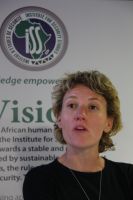Thursday, April 18, 2024
News and Views from the Global South
SOUTH AFRICA: Will Soccer World Cup Attract Human Traffickers?
Miriam Mannak
- A fierce debate has erupted over claims that the 2010 Soccer World Cup will fuel the trafficking of women from African and other countries to South Africa for sexual exploitation during the cup, which starts on Jun 11.

Marlise Richter: Many sex workers "come from Zimbabwe or the Democratic Republic of the Congo as economic migrants and out of their own free will." Credit: Miriam Mannak/IPS
Dr Chandré Gould, senior researcher at the Institute for Security Studies (ISS) and author of ‘‘Selling Sex in Cape Town: Sex Work and Human Trafficking in a South African City”, dismisses the campaign’s message. According to her, the figures are severely inflated.
“Prior to the previous World Cup in 2006, 40,000 women were expected to be trafficked to Germany for sexual purposes,” she said at an ISS public seminar in Cape Town, South Africa, on May 24. ISS is a pan-African policy research think tank concerned with human security.
“The International Organisation for Migration (IOM) later found no increase of human trafficking during the event and that the number of 40,000 victims was unfounded. Neither is there proof to link big sporting events and human trafficking.
“We don’t know what is going to happen in South Africa but there is no reason to believe that the situation will differ from Germany. There will be six times less visitors in South Africa compared to the 2006 World Cup but some people still put the predicted number of trafficked persons at double the prediction for the 2006 cup.”
Gould noted that the problem of human trafficking generally is being overestimated. “Many media reports are based on improbable numbers that are built on insufficient data which are repeated in reports.
“For instance, UNICEF (the United Nations Children’s Fund) in 2005 repeated a claim that human trafficking was beginning to rival the drugs and arms trade as it was generating more than 10 billion dollars in revenue.
“If you look at where this number comes from, you realise that it was a mistake made by someone sitting at a desk at the U.S. department of state. This mistake is being repeated over and over again because it looks like a credible number and the media love numbers.”
But investigative journalist Mark Thomas questioned Gould’s statements at the seminar, based on his research into human trafficking and the South African sex industry.
“I would agree that nobody truly knows how much is generated by the trade but it is wrong to dismiss any suggested figure out of hand,” he told IPS. Thomas is news editor at the South African investigative news magazine Noseweek.
“There is not a single source that has stated with certainty that the annual revenue is 10 billion dollars. The UN, the Council of the European Union, the IOM, and several anti-human trafficking organisations all use the term ‘estimated to generate revenue of between five and nine billion dollars per year’.”
The gap between the two figures can be explained by the concealed nature of human trafficking, Thomas explained.
“Payments for services associated with illicit activities remain hidden. No single trafficker, some of whom have seemingly legitimate businesses, would ever declare amounts received as a result of illicit activities in their financial records,” he added.
Gould stated that none of the research of the past decade showed an increase in trafficking of women to South Africa. “The IOM over the past six years has found and assisted 315 victims of human trafficking. That is all. That is the extent of the problem as we know it.
“One needs to keep in mind that the IOM has trained over 10,000 law enforcement officials in Southern Africa to deal with human trafficking and there is a 24-hour hotline.”
Gould’s own research, published in 2008, found 1,209 sex workers in Cape Town, of whom 964 worked in brothels and 245 on the streets.
Out of 164 people interviewed, “we discovered eight cases of women that might have been trafficked. The brothel owners we interviewed said they and their clientele had no interest in foreign women. This could be related to the fear of being raided by the department of home affairs,” Gould explained.
Thomas questioned these claims. “In my research in Cape Town in 2009, I spoke to many women who were trafficked. For one story I spoke to 24 who were from Nigeria, Cameroon, Zimbabwe, Rwanda, Uganda, Kenya and Zambia. A few were reluctant to disclose their nationalities.
“This was accomplished within the first two weeks of research,” he added.
But “not all foreign women that are working in the South African sex industry have been trafficked”, Marlise Richter, associate researcher at the forced migration studies programme at the University of the Witwatersrand in Johannesburg, said at the seminar.
“Many of them come from Zimbabwe or the Democratic Republic of the Congo as economic migrants and out of their own free will. They do not see it as a life-long career but as a way to make some money before returning home,” she said.
Thomas also disagreed with Richter’s statements. “You don’t need a gun pointing at your head to be forced to do what you don’t like. The women she mentioned might not have been trafficked but they have been forced into this industry, as is shown by the fact that they see it as the only way to earn income. Most of them don’t do this work voluntary.”

 Print
Print



